In this article, you will explore the fascinating craft of Thai wood carvings and gain insight into their intricate craftsmanship. We will take a journey into the world of Thai wood carving, delving into its rich cultural background and historical significance. You will learn about the various techniques used in this art form and discover the stories and symbolism behind these intricate masterpieces. Whether you are a fan of art, culture, or simply curious about the unique traditions of Thailand, this article will provide you with a deeper understanding and appreciation for the beauty of Thai wood carvings.
The History of Thai Wood Carvings
Influences from Indian and Chinese art
Thai wood carvings have a rich history that can be traced back to the influence of Indian and Chinese art. During the first millennium, as Buddhism spread to Southeast Asia, it brought along with it the artistic traditions of India. This included intricate wood carvings that adorned temples and statues. The influence of Chinese art can also be seen in the use of symbolic motifs and intricate patterns in Thai wood carvings.
Development of distinct Thai style
Over time, Thai wood carvers developed their own distinct style, blending elements from both Indian and Chinese art with their own cultural and artistic sensibilities. They began to create carvings that reflected the unique Thai identity and showcased the craftsmanship and artistic skills of the Thai people.
Importance in Thai culture
Thai wood carvings hold great importance in Thai culture. They are not only seen as works of art but also as expressions of religious and cultural beliefs. Carved wooden sculptures and decorations can be found in temples, palaces, and homes across Thailand, acting as a visual representation of the country’s cultural heritage and traditions.
Techniques and Tools Used in Thai Wood Carvings
Traditional carving tools
Thai wood carvers employ a range of traditional carving tools to bring their creations to life. These tools include chisels, gouges, knives, and mallets of various sizes and shapes. Each tool is carefully selected and skillfully used to achieve the desired level of intricacy and detail in the carving.
Different types of wood used
Thai wood carvers work with a variety of woods, each possessing its own unique characteristics and suitability for different carving styles and purposes. Teak, rosewood, and sandalwood are commonly used for their durability and beauty. The selection of wood depends on factors such as the size of the carving, the level of detail required, and the desired finish.
Process of carving and shaping
The process of carving a Thai wood carving begins with the selection of a suitable piece of wood. The wood is then roughed out using larger carving tools, gradually shaping it into the desired form. Once the basic shape is achieved, finer tools are used to carve intricate details and patterns. The carver’s skill and precision are evident in every stroke, resulting in a finished piece that showcases their craftsmanship.
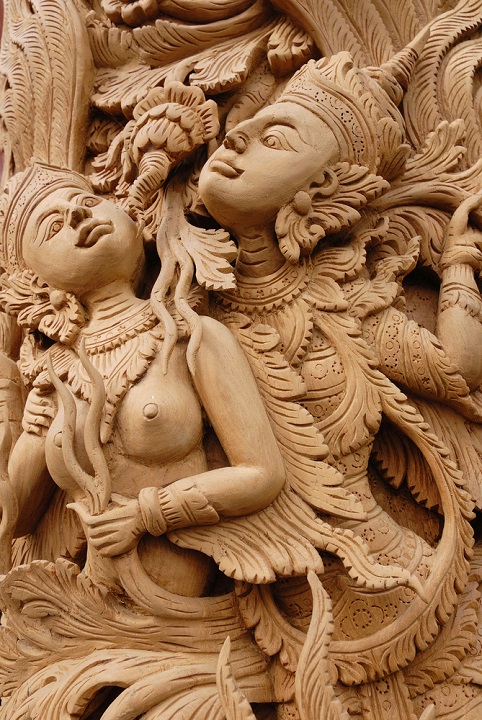
Symbolism and Meaning in Thai Wood Carvings
Religious and spiritual significance
Many Thai wood carvings have religious and spiritual significance, often depicting scenes from Buddhist stories and mythology. These carvings serve as reminders of important teachings and beliefs, encouraging devotion and reverence among the Thai people.
Depictions of mythical creatures and deities
Thai wood carvings frequently feature depictions of mythical creatures and deities. The intricate details and lifelike representations of these figures reflect the high level of craftsmanship and artistry of Thai wood carvers. Such carvings are believed to bring luck, protection, and blessings to those who possess them.
Representation of Thai folklore
Thai wood carvings also depict scenes from folklore and legends, showcasing the rich cultural heritage of Thailand. These carvings often depict epic battles, heroic deeds, and moral lessons, providing a glimpse into the history and values of the Thai people.
Regional Variations in Thai Wood Carvings
Styles and motifs in Northern Thailand
In Northern Thailand, wood carvings typically feature intricate floral and nature-inspired motifs. The carvings often incorporate elements from the Lanna tradition, known for its delicate and symmetrical designs. The use of gold leaf and vibrant colors further embellishes these carvings, creating a visually stunning piece of art.
Distinctive characteristics of Southern Thailand carvings
Wood carvings from Southern Thailand often exhibit a more bold and abstract style. The carvings may feature geometric patterns or symbolic representations of marine life, reflecting the region’s coastal heritage. The wood used in these carvings is often lighter in color, allowing the intricate details to stand out.
Unique influences found in Central Thailand carvings
Carvings from Central Thailand often showcase a blend of different influences, combining elements from Northern and Southern Thai traditions. The carvings in this region are known for their exceptional attention to detail and fine craftsmanship. Intricately carved panels and decorative architectural elements are common features in Central Thai wood carvings.
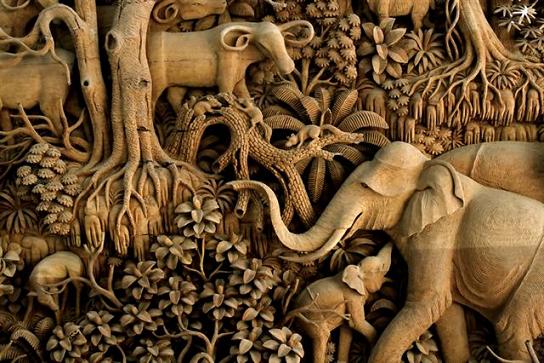
Famous Thai Wood Carvers
Prominent artists and their contributions
Thai wood carving has produced many talented artists whose works have gained international recognition. One such artist is Chit Buabusaya, who specializes in intricate and lifelike animal carvings. His sculptures have been exhibited in galleries around the world and have received numerous awards for their exceptional craftsmanship.
Notable workshops and schools
Several workshops and schools in Thailand offer training programs and apprenticeships for aspiring wood carvers. These institutions provide the opportunity to learn from experienced masters and develop skills in the art of wood carving. The Chiang Mai Vocational College is renowned for its wood carving program, attracting students from both Thailand and abroad.
Impact on the art community
Thai wood carvers have made a significant impact on the art community, both within Thailand and internationally. Their intricate and skillful creations have garnered admiration and appreciation from art enthusiasts and collectors around the world. The unique blend of traditional techniques and contemporary influences has led to the evolution of Thai wood carving as a recognized and respected art form.
Preservation and Conservation Efforts
Preservation of ancient carvings
Efforts are being made to preserve and protect ancient Thai wood carvings that are at risk of deterioration or destruction. Conservation experts work to restore damaged carvings, employing techniques that maintain the integrity and originality of the artwork. These efforts ensure that future generations can continue to appreciate the beauty and historical significance of Thai wood carvings.
Challenges in protecting wood carvings
Preserving wood carvings poses several challenges, such as exposure to environmental factors like humidity and pests. Additionally, the increasing demand for antique carvings has led to illegal trafficking and looting of cultural artifacts. Collaborative efforts between government agencies, art institutions, and local communities are crucial in effectively safeguarding Thai wood carvings.
Collaboration with cultural heritage organizations
Cultural heritage organizations in Thailand actively collaborate with wood carvers to promote the preservation and conservation of Thai wood carvings. These organizations provide technical support, funding, and access to resources that help ensure the long-term sustainability of the craft. By working together, they aim to protect Thailand’s cultural heritage and raise awareness about the importance of preserving traditional crafts.
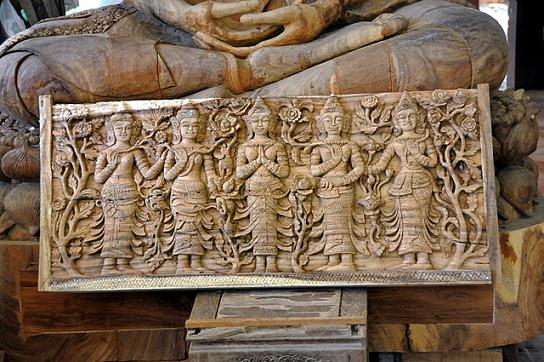
Contemporary Applications of Thai Wood Carvings
Integration in architectural designs
Thai wood carvings are often incorporated into architectural designs, adding a touch of intricate beauty and cultural significance to various structures. Temples, palaces, and royal residences frequently feature decorative carvings that enhance the visual appeal and spiritual atmosphere of these spaces. The intricate patterns and symbolic motifs of Thai wood carvings provide a unique charm and elegance to architectural designs.
Modern interpretations in furniture and decor
Thai wood carvings have also found a place in modern furniture and decor. Contemporary designers often incorporate traditional elements of Thai wood carving into their creations, blending the old with the new. Intricately carved furniture pieces, such as tables, chairs, and cabinets, bring a sense of craftsmanship and cultural heritage into modern interiors.
Recognition in international art exhibitions
Thai wood carvings have gained recognition in international art exhibitions, further showcasing the talent and artistry of Thai wood carvers. These exhibitions provide a platform for artists to display their works to a global audience and foster cultural exchange. Through participation in international exhibitions, Thai wood carvings have become ambassadors of Thai culture and artistic traditions.
Wood Carving as a Cultural Trade
Economic significance in Thai communities
Wood carving holds economic significance in many Thai communities, providing livelihoods for artisans and stimulating local economies. The demand for Thai wood carvings, both domestically and internationally, creates opportunities for skilled craftsmen and encourages the growth of local industries. The craft has become a source of pride and cultural identity for Thai communities.
Training and apprenticeship programs
To ensure the sustainability of the craft, training and apprenticeship programs have been established to pass on the knowledge and skills of Thai wood carving to future generations. These programs offer aspiring wood carvers the opportunity to learn from experienced craftsmen, honing their talents and keeping the tradition alive.
Role in promoting tourism
Thai wood carvings play a significant role in promoting tourism in Thailand. Many visitors are drawn to the country’s rich cultural heritage, and wood carving is often included in cultural tours and heritage experiences. Wood carving workshops and demonstrations provide tourists with an opportunity to witness the intricate craftsmanship firsthand, fostering a deeper appreciation for Thai culture.
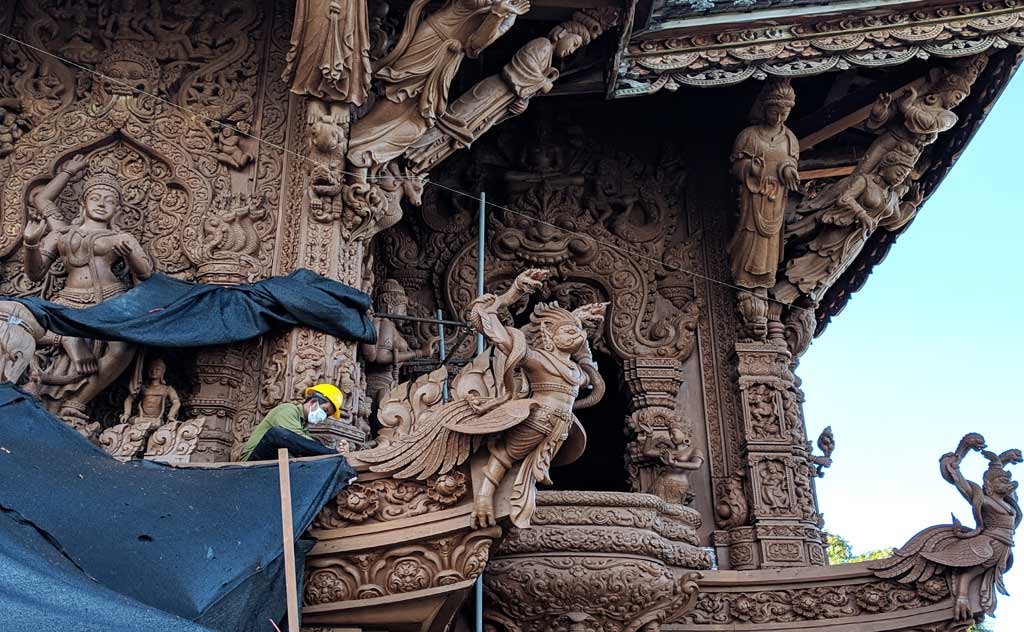
Thai Wood Carvings in Traditional Rituals and Ceremonies
Use in religious ceremonies
Thai wood carvings are an integral part of religious ceremonies and rituals in Thailand. They adorn temples and shrines, serving as offerings to deities and symbols of devotion. Thai people believe that the presence of wood carvings within these sacred spaces enhances spiritual energy and invites blessings.
Role in cultural celebrations and festivals
Wood carvings are prominently featured in cultural celebrations and festivals throughout Thailand. Elaborately carved floats, statues, and decorative elements are paraded through the streets during festivities, captivating onlookers with their beauty and cultural significance. These carvings not only add to the visual spectacle of the events but also reinforce the importance of traditional crafts in Thai culture.
Blessings and symbolism in Thai rituals
In addition to their visual appeal, Thai wood carvings carry deep symbolic meanings in various rituals and ceremonies. They are believed to bring prosperity, good luck, and protection to those who possess them. Thai people often seek the blessings of wood carvings as they believe in the spiritual power and positive energy emanating from these sacred objects.
Famous Wood Carving Markets and Galleries in Thailand
Exploration of Chatuchak Weekend Market
Chatuchak Weekend Market in Bangkok is a treasure trove of Thai wood carvings. The sprawling market offers a wide variety of carved sculptures, decorative items, and furniture pieces. Visitors can immerse themselves in the vibrant atmosphere and browse through the stalls, discovering unique and intricately crafted wood carvings to take home as souvenirs or art pieces.
Discovering Chiang Mai’s Nimmanhaemin Art District
Chiang Mai’s Nimmanhaemin Art District is a hub of creativity, where artisans and artists showcase their works, including wood carvings. The district is known for its contemporary art scene, with numerous galleries and boutiques featuring the works of local and international artists. Exploring this district provides an opportunity to appreciate the fusion of traditional and modern influences in Thai wood carving.
Visiting renowned wood carving galleries in Bangkok
Bangkok is home to several renowned galleries dedicated to Thai wood carvings. These galleries offer curated collections of exquisite carvings, allowing visitors to admire the craftsmanship and learn about the cultural significance of the artworks. Visiting these galleries provides a deeper insight into the world of Thai wood carving and its place in contemporary art.
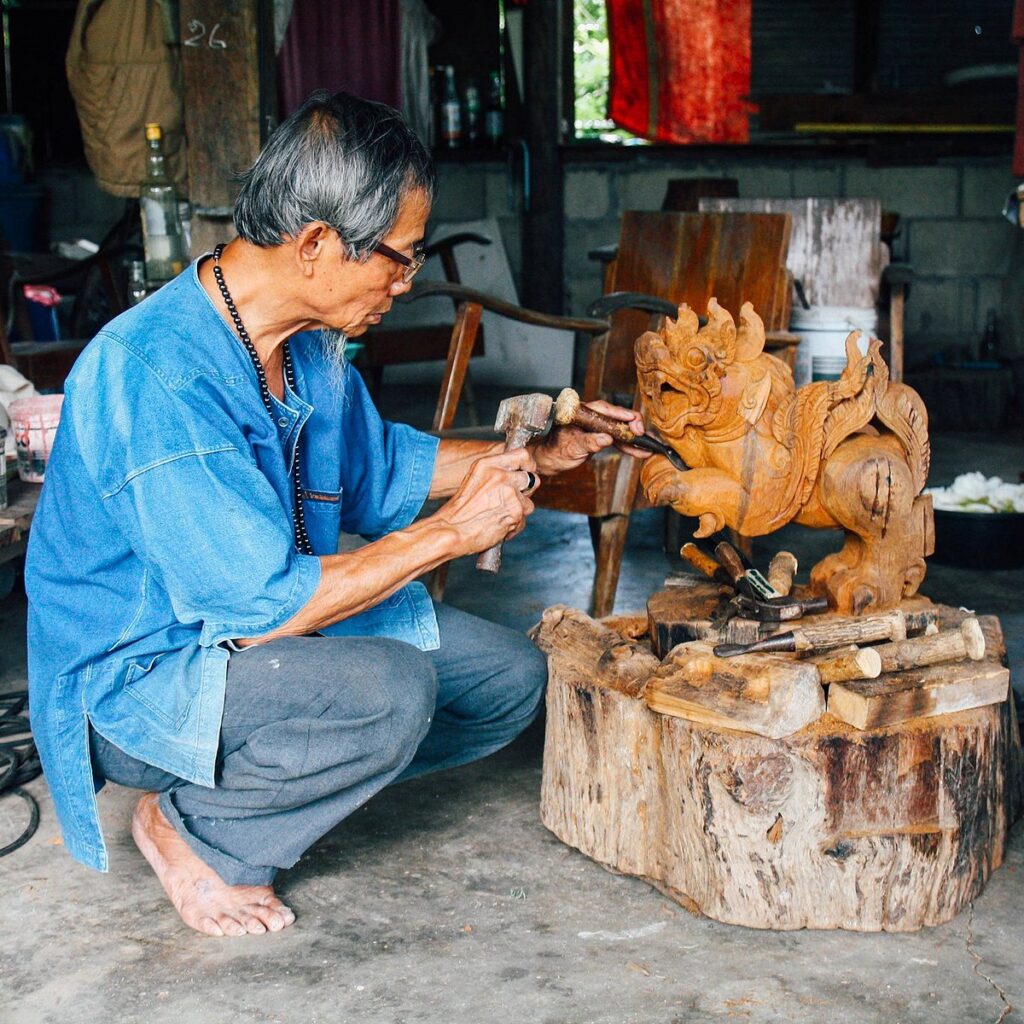
The Evolution of Thai Wood Carvings in Contemporary Art
Inspiration for contemporary artists
Thai wood carvings have become a source of inspiration for contemporary artists who seek to push the boundaries of traditional techniques and styles. The intricate details and cultural symbolism found in Thai wood carvings serve as a foundation for experimentation and reinterpretation, resulting in innovative and thought-provoking artworks.
Experimentation with new techniques and styles
Contemporary artists are exploring new techniques and styles in Thai wood carving, incorporating modern tools and materials into their practice. They blend traditional carving methods with contemporary art influences, creating pieces that reflect the changing times while honoring the rich heritage of Thai wood carving.
Exploration of social and political themes
Thai wood carving has also become a medium for social and political commentary. Contemporary artists use the craft to address pressing issues and raise awareness about social justice, environmental conservation, and cultural identity. By infusing their wood carvings with powerful messages, these artists contribute to the ongoing dialogue and reflection on Thai society.
Appreciating Thai Wood Carvings: Tips for Collectors
Understanding authenticity and craftsmanship
When collecting Thai wood carvings, it is important to understand the authenticity and craftsmanship of the pieces. Authentic carvings are typically handmade and showcase intricate details and fine artistry. It is also essential to consider the quality of the carving, evaluating the precision, balance, and overall aesthetic appeal.
Evaluating the condition and quality of carvings
Inspecting the condition and quality of wood carvings is crucial when building a collection. Look for signs of damage, such as cracks, discoloration, or missing pieces. Consider the type of wood used and its durability over time. Acquiring carvings from reputable sources and galleries ensures the integrity and authenticity of the pieces.
Building a collection and connecting with experts
Building a collection of Thai wood carvings is a rewarding journey that requires research and patience. Visit art exhibitions, galleries, and markets to explore different styles and artists. Connect with experts and collectors in the field to gain insights and guidance. Building relationships with artists and artisans can provide deeper knowledge and a deeper appreciation for Thai wood carving.
The Influence of Thai Wood Carvings on Traditional Thai Architecture
Incorporation of intricate carvings in temples and palaces
Thai wood carvings have played a significant role in traditional Thai architecture. They are often incorporated into the design and decoration of temples, palaces, and other cultural landmarks. Elaborate relief carvings adorn entrance gates, walls, and pillars, adding a touch of grandeur and spiritual significance to these structures.
Symbolic meanings in architectural designs
Thai wood carvings in traditional Thai architecture are filled with symbolic meanings and cultural references. The carvings depict mythical creatures, gods, and important historical figures, conveying stories and values that are integral to Thai culture. These symbols enrich the architectural design, creating a visual narrative that resonates with the Thai people.
Continued relevance in modern Thai architecture
Thai wood carving continues to enjoy relevance in modern Thai architecture. While contemporary designs may incorporate more minimalist elements, the use of wood carvings is still present, often in a more subtle and refined manner. These carvings serve as a link between the past and the present, honoring the country’s rich cultural heritage while embracing innovation.
Conclusion
Exploring the intricate craftsmanship of Thai wood carvings takes you on a journey through Thailand’s rich cultural heritage. From the influences of Indian and Chinese art to the development of distinct Thai styles, these carvings showcase the skill, artistry, and dedication of Thai wood carvers. The deep symbolism and cultural significance of Thai wood carvings make them a unique and treasured art form. Whether visiting famous wood carving markets, appreciating contemporary interpretations, or collecting these masterpieces, Thai wood carvings offer a profound connection to Thai culture and a visual feast for the senses.
